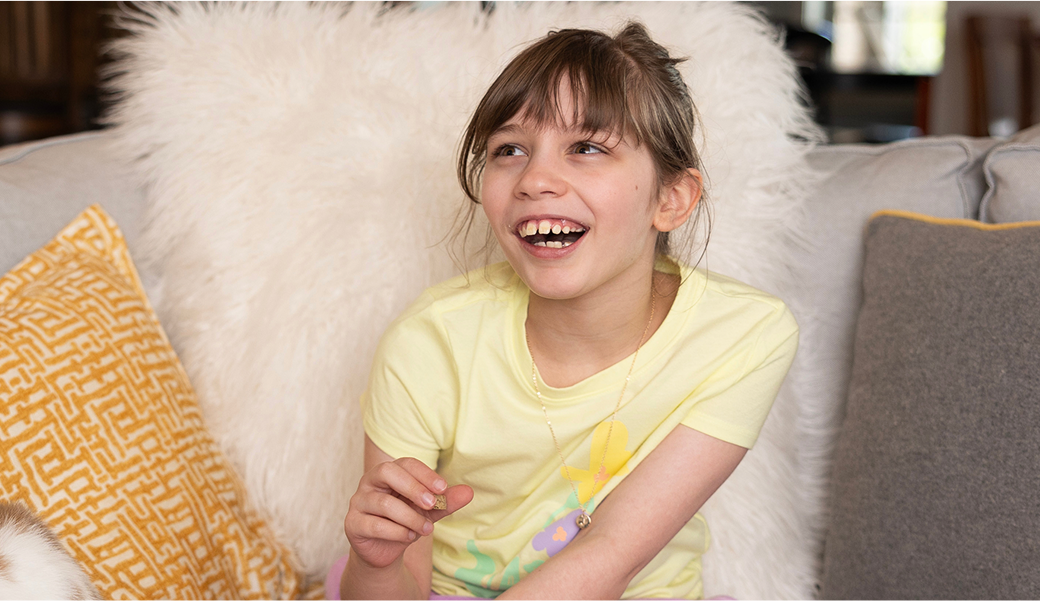
Understanding Dravet
What Is Dravet Syndrome?
Dravet (pronounced “drah-VAY”) syndrome is a rare, hard-to-treat form of epilepsy.1-4
- It occurs in 1 in 15,700 births in the United States, and symptoms usually start in the first year of a child’s life5
- The first seizure occurs in an otherwise normally developing infant, between ages 5 and 8 months, usually triggered by a fever, illness, or hot bath
- Dravet syndrome is named after Dr. Charlotte Dravet. It was previously known as severe myoclonic epilepsy in infancy (SMEI)4
- It is a spectrum disorder, which means that the severity and types of seizures and disability varies by person and age4
Genetic Testing and Dravet
For patients with Dravet, brain scans and tests, like an initial electroencephalogram (EEG), may appear normal.6 For that reason, genetic testing is highly recommended and may support a diagnosis.
Though not fully conclusive, research shows that over 90% of patients with Dravet syndrome have a mutation in the SCN1A gene.4,7
- The SCN1A gene impacts the channels involved in sending signals between nerve cells8
- The mutation is often “de novo” (or “new”), meaning that neither parent carries the mutation. Only about 5%-10% of cases are inherited from a parent2
- Some patients will have a mutation in the gene and not have seizures. Other patients without the gene mutation might have seizures that look like Dravet syndrome1
Early Intervention Matters
Getting your loved one’s seizures under control as soon as possible is an essential treatment goal. Children who experience frequent and prolonged seizures may be at risk for several medical and developmental issues.2,9
These may include:
Slow developmental progression
Delayed language development
Poor appetite and eating habits
Poor coordination
Decreased muscle tone
Inattention or hyperactive behavior
Sleep difficulties
Crouched gait
It is scary to talk about, but children with Dravet syndrome are also at risk for sudden unexpected death in epilepsy (SUDEP). Those who experience tonic-clonic seizures are at higher risk for SUDEP, and that risk increases further with seizure frequency.10,11
Growing up With Dravet
The good news is that as children get older:2,6,12
- The number and length of seizures may decrease
- Prolonged seizures and seizures that require hospitalization are less common
- They are still able to learn new things and gain new skills
Each child’s development is affected differently by Dravet, and the Dravet Syndrome Foundation offers resources to support caregivers like you throughout your loved one’s life.


Explore the Caregiver Brochure
Use this guide to help you initiate a conversation with your loved one’s doctors to determine if DIACOMIT is the right fit for their treatment plan.
References
1. Wheless JW, Fulton SP, Mudigoudar BD. Dravet syndrome: a review of current management. Pediatr Neurol. 2020;107:28-40. 2. Villas N, Meskis MA, Goodliffe S. Dravet syndrome: characteristics, comorbidities, and caregiver concerns. Epilepsy Behav. 2017;74:81-86. 3. Shmuely S, Sisodiya SM, Gunning WB, Sander JW, Thijs RD. Mortality in Dravet syndrome: a review. Epilepsy Behav. 2016;64(pt A):69-74. 4. Dravet C. The core Dravet syndrome phenotype. Epilepsia. 2011;52(suppl 2):3-9. 5. Wu YW, Sullivan J, McDaniel SS, et al. Incidence of Dravet syndrome in a US population. Pediatrics. 2015;136(5):e1310-e1315. 6. Wirrell EC, Laux L, Donner E, et al. Optimizing the diagnosis and management of Dravet syndrome: recommendations from a North American consensus panel. Pediatr Neurol. 2017;68:18-24. 7. Scheffer IE, Zuberi S, Mefford HC, et al. Development and epileptic encephalopathies. Nat Rev Dis Primers. 2024(10);10(1):61. 8. Surovy M, Soltysova A, Kolnikova M, et al. Novel SCN1A variants in Dravet syndrome and evaluating a wide approach of patient selection. Gen Physiol Biophys. 2016;35:333-342. 9. Dravet Syndrome Foundation. What is Dravet syndrome? http://www.dravetfoundation.org/what-is-dravet-syndrome. Accessed November 16, 2020. 10. Wirrell EC, Hood V, Knupp KG, Meskis MA, Nabbout R, Scheffer IE, Wilmshurt J, Sullivan J. International consensus on diagnosis and management of Dravet syndrome. Epilepsia. 2022;63(7):1761-1777. 11. Sveinsson O, Andersson T, Mattsson P, Carlsson S, Tomson T. Clinical risk factors in SUDEP: A nationwide population-based case-control study. Neurology. 2020;94(4):e419-e429. 12. Dravet Syndrome Foundation. Comorbidities in Dravet syndrome. https://dravetfoundation.org/what-is-dravet-syndrome/comorbidities/. Accessed August 4, 2022.